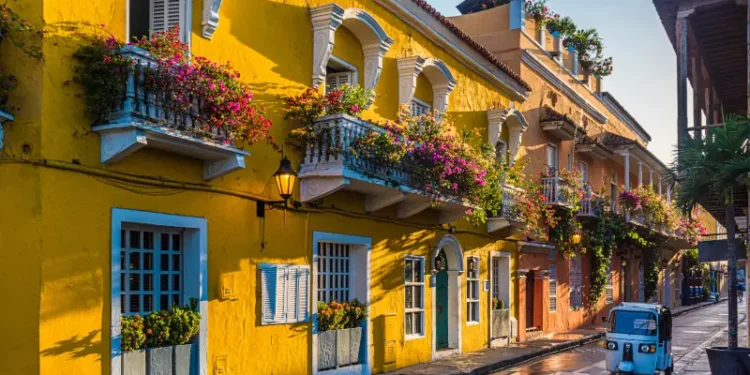Low costs, great health care, and welcoming communities await. These are the best places to live in Colombia for expats and retirees.
1. Medellín
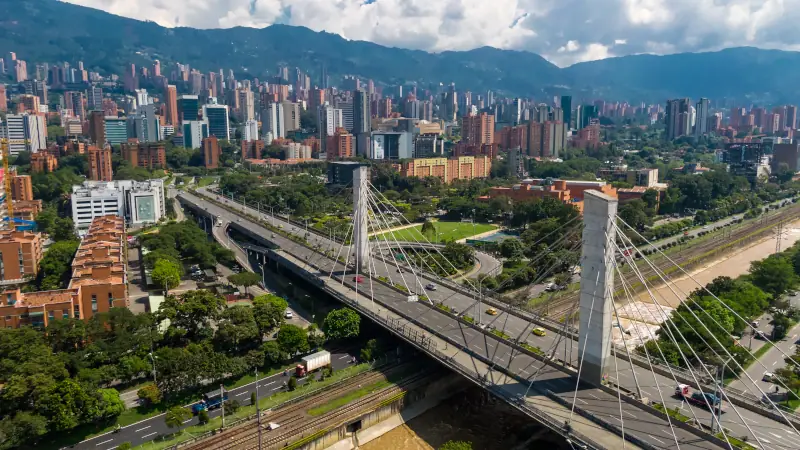
Known as “the city of eternal spring”, Medellín is one of the world’s most livable cities. It offers an efficient public transportation system, friendly locals, a well-established expat community, ample green spaces, and weather that most people would describe as perfect. The temperature never strays far from 74°F (23°C).
The climate is so stable because of the city’s elevation. It sits at 4,900 feet (1,495 meters) above sea level, which prevents big swings in temperature.
Medellín is Colombia’s capital of culture. It offers so much to do, see, and enjoy that it’s impossible to be bored here.
There’s festivals, fairs, museums, galleries, shopping malls and boutiques, and a diverse culinary scene, with everything from laidback local joints to fine dining. Plus, modern movie theaters with English-language movies and VIP seating.
Festivals take place throughout the year, but Feria de las Flores, the flower festival held each August, deserves special mention. Already a verdant region, Medellín comes alive with eye-catching colors when a myriad of plants bloom in its springtime. There are also festivals dedicated to music, literature, dance, and more.
This is an active city, and locals are generally health and appearance conscious. On any given day, you’ll see people out exercising—doing sports, Zumba, running, cycling, dancing, or working out at outdoor gyms.
Medellín sits in a valley, so it’s surrounded by green hills where you can walk, cycle, or hike. Parque Arví is one famous example. Perched on a hill, you reach it by cable car. It’s a sprawling nature reserve and archaeological site with 54 miles of trails through the forest, nature tours, cycling, and outdoor adventure sports.
Medellín’s expat community has grown in recent years. Thanks to its low cost of living, excellent infrastructure, and reputation as an interesting place to spend time, Medellín has become more popular, particularly among remote workers and digital nomads. It’s also popular with retirees, single women, couples, and young families with children.
There are certain areas of the city (El Poblado, first and foremost, but also Laureles, Evigado, and other areas) where you’re almost guaranteed to bump into fellow expats as you go about daily life.
As it rises in popularity as a tourist destination, more English is spoken in Medellín every year. There are pockets of the city, like El Poblado, where you could maybe get by without speaking Spanish… But to live a full life here, you need to learn at least the basics. And this is a great place to learn, so don’t worry if your español isn’t up to par just yet.
Medellín offers a high quality of living at a very low cost. A monthly budget of $1,800 will cover a couple here.
Medellín is home to several top-tier hospitals, including the JCI-accredited Hospital Pablo Tobón Uribe and Clínica Medellín. Both public and private facilities are available, although expats pay for private insurance to use the private facilities where standards are highest.
Medellín has become a hub for medical tourism because of the affordability, quality, and advanced equipment and services. Many medical professionals have international training.
Why Live Or Retire Here:
- Spring-Like Weather Year-Round.
- Upscale Living From $1,800 A Month.
- First-Rate Health Care Options.
2. Santa Marta
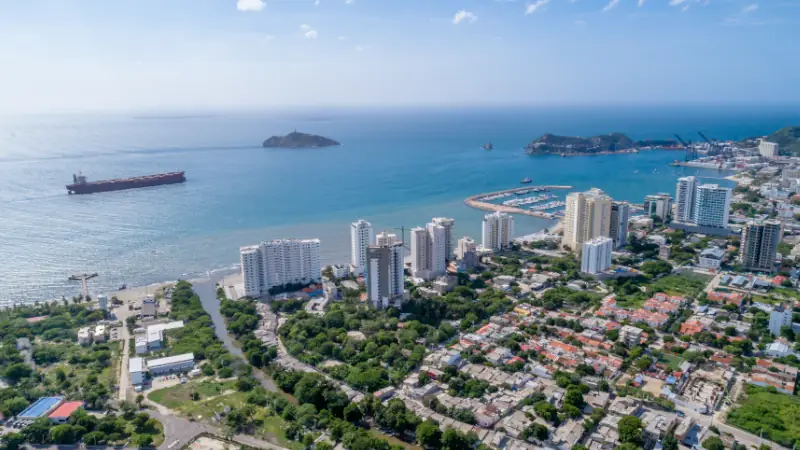
While mostly unknown to international audiences, Santa Marta is the preferred vacation destination for locals, favored for its low costs, warm climate, and beautiful beaches.
It’s a well-positioned spot, with the Caribbean Sea to the north and west, Tayrona National Park to the east, and Colombia’s Sierra Nevada mountain range to the south.
There’s an upbeat and energetic culture and a diverse selection of lifestyle opportunities on offer here. You can hike, bike, snorkel, dive, trek, boat, or swim. Take in the white-washed Spanish-colonial architecture in the town’s historical heart, or wander the attractive seafront park and explore the boutiques, cafés, bars, and restaurants in the newer part of the city.
Santa Marta stands out for being fantastically affordable. It’s priced for the local market rather than the international one. A monthly budget of $1,800 would cover a couple here.
The climate is tropical-dry meaning it’s hot year-round and you will want A/C in your home. The average high is 91°F (33°C) and average low is 75°F (24°C).
With all that sunshine it’s no surprise that Santa Marta’s Caribbean beaches are its main appeal. Rodadero is the most popular, with soft, golden sand and restaurants and bars on the shorefront. You can rent jet skis and arrange boat trips from the beach.
The area that surrounds Santa Marta offers many off-the-beaten-path recreation opportunities. It’s right next to the Sierra Nevada mountain range—one of the highest coastal ranges in the world.
The mountains provide opportunities for hiking, trekking, mountain biking, splashing in waterfalls and rivers, and wildlife spotting. There are mountain villages you can visit to enjoy slightly cooler weather, as well as coffee farms where you can sample Colombia’s high-quality brew.
For health care needs, Santa Marta has over a dozen hospitals, clinics, and health centers, both public and private. You should be able to meet all your medical needs within the city, but finding an English-speaking doctor will be more of a challenge. In general, you’ll want to have a decent grasp of Spanish to make the most of life in this spot.
Santa Marta doesn’t have a substantial expat community. It provides an opportunity to have an adventure and live a more authentic Colombian lifestyle rather than a replica of the lifestyle you had back home.
From the lively bay at Taganga to the classic port ambience of Santa Marta, from the energy of El Rodadero to the gleaming towers of the Southern Sector, Santa Marta has something for everyone.
If you’re looking for a colonial Caribbean city with less bustle and more bargains than the famous Cartagena… then Santa Marta could be right for you.
Why Live Or Retire Here:
- Live Well On $1,800 A Month.
- A Sun-Kissed Retirement By The Sea.
- To Embrace Authentic Colombian Life.
3. Cartagena
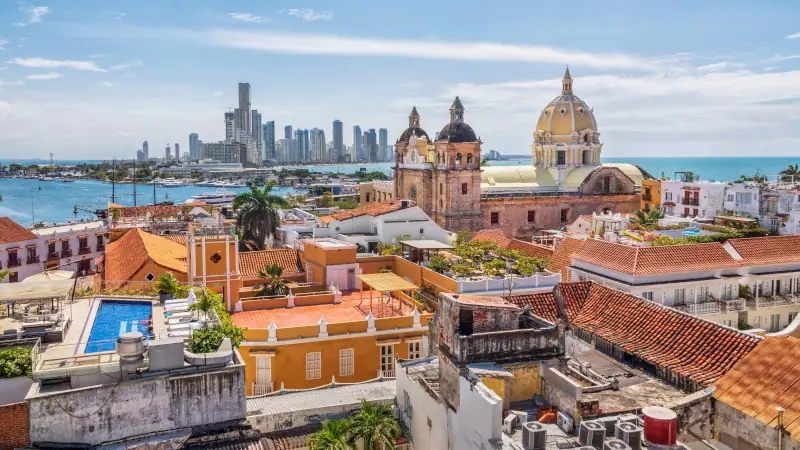
If you’re looking for a place that’s romantic, vibrant, and—as described by many—magical, look no further.
Cartagena is a coastal city with a humid and tropical climate. It is warm year-round, and temperatures range between their lowest at about 73°F (23°C) and their highest at 91°F (33°C). The city goes through a dry season from December to April and a rainy season from May to November.
Cartagena is completely walkable but the heat can make that tough at times. Uber, taxis, and buses are readily available and cheap.
A budget of around $2,000 a month will cover your costs here. Rents in upscale neighborhoods start around $690 a month and you can find ocean view apartments from $930 a month.
Utilities depend on usage and on the property estrato that you live in. Estratos 4, 5, and 6, pay more to subsidize the lower estratos.
On average, for an estrato 4 property in Cartagena you will pay about 52,466 pesos (about $13) for water per month. For gas, you would pay on average about 15,065 pesos per month (about $3.50). For electricity in Cartagena, you will pay 799 pesos (about $0.19) per kWh. For an 80-square-meter apartment, you could be paying around $60 to $70 per month.
There’s a well-organized real estate industry in Cartagena with a generous inventory of quality properties. Construction standards are high— even in older buildings—yet prices are lower than you’ll find in many Caribbean markets… amazing value when compared to Cartagena’s quality of life and amenities.
A considerable number of expats call Cartagena their home. There’s a big community of Americans, Brits, and Latin Americans. Many are teachers, retirees, digital nomads, and businesspeople.
Cartagena feels very much like a small town, and you’ll likely run into people all the time. You can join the many expat Facebook groups available where you can learn about meetups and activities the community takes part in together.
If you plan on retiring to Cartagena or making it your second home, we recommend you learn Spanish. This will get you a long way with locals and will allow you to connect better with your new community. It will also help not to feel like a tourist in the place that is supposed to be your new home.
For health care needs, Cartagena’s most modern hospital, Hospital Universitario Carlos Haime, is the first specialized institution for cancer treatment in the region. The hospital carries an intensive care unit, cardiology, endoscopy, MRI, delivery rooms, chemotherapy, radiotherapy, and more.
They have a special office for international patients to ensure they receive information in their native language. The care here is top-notch, and as this is a private hospital, prices may be higher than in others in the city, but it’s still far less expensive than in North America. For less urgent medical care, several clinics are available in the city.
If your ideal overseas haven is a fast-paced, vibrant coastal city environment that blends the old with the modern, is walkable with beaches, exciting nightlife, well-preserved Spanish colonial architecture, offers great gastronomy, property bargains, and a low cost of living, then you’ll find it all in Cartagena.
Why Live Or Retire Here:
- Bargain Real Estate.
- Big City Conveniences And Coastal Living.
- First-Rate Health Care.
4. Cali
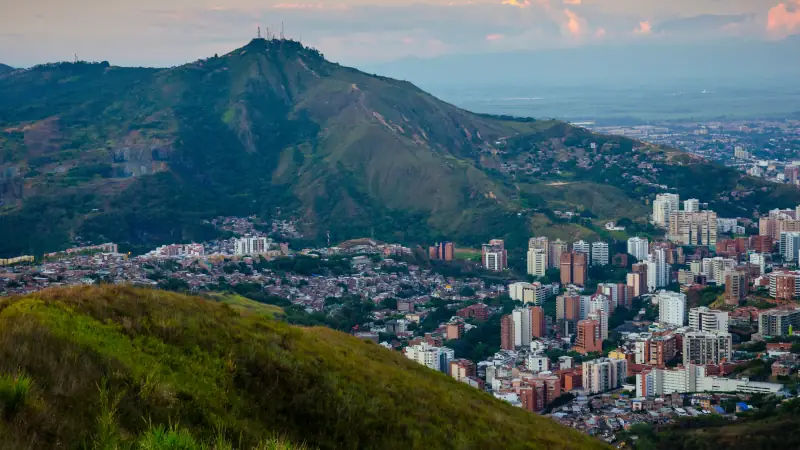
Santiago de Cali, also known as Cali, is considered the salsa capital of Colombia and the “city of eternal summer.” At an elevation of 3,340 feet (1,018 meters), Cali is located in a valley with mountains to the west, the Cauca River to the east and plains to the north and south.
Cali is well positioned—it’s about two hours by road from the Pacific Coast and only about three hours by road from Colombia’s coffee region, meaning you can go whale watching or explore the “eje cafetero” on the weekends.
Cali boasts drinkable water along with dependable phone service, electricity, and high-speed internet. You’ll find many shopping options, from mom-and-pop stores to upscale boutiques… as well as several large, modern shopping malls. The banks and financial services in the city are the same as you will find in Bogotá and Medellín, and they are solid and dependable.
Cali is considered by many to have the best nightlife in Colombia. There are countless bars and clubs, many salsa-based, but also with other themes like rock and reggaeton. If you like dancing, brush up on a few steps before you arrive or take some classes once you get here. In Cali, knowing how to dance may even be more important than knowing Spanish.
On that note, English is not widely spoken in Cali outside the service and tourist industries. However, there are many multinational businesses in the city, so you’ll sometimes find English speakers in hotels and restaurants. Even some of the taxi drivers and shopkeepers speak some English.
From the hole-in-the wall shop selling homemade empanadas to elegant restaurants with fine cuisine, your dining experience will be varied in Cali with a tremendous number of options in the city. And what’s more, the sizzling nightlife in Cali draws visitors from the entire country.
Cali is known to have an eternal summer climate, with temperatures averaging 75°F (23.9°C) year round with little variation. The daily average high ranges from 84°F to 86.4°F (28.9°C to 30.2°C), but the high does get above 90°F at times.
Crime in Cali is a mixed bag depending on where you are, similar to other cities in Colombia and in Latin America. Most of the western neighborhoods are considered some of the safest areas, with virtually no homicides and little crime.
Some of the northern neighborhoods are also considered safe, including Santa Mónica, Granada, Centenario, and Juanambú. The far south neighborhoods of Ciudad Jardín and Pance are generally considered safe, too.
Like any big city, Cali has some neighborhoods were crime is prevalent. If you stay out of the bad neighborhoods, you will likely avoid 95% of the problems that give the city a bad reputation.
Cali has a small but slowly growing permanent expat community as well as a growing snowbird expat community that are in the city to escape the snow during winter months up north.
A monthly budget of $1,500 or more will put you in one of the city’s better neighborhoods, in a higher-end residence. If you wanted to live for less, you could easily do it by settling in a middle-class neighborhood and staying away from the high-end restaurants. You could also spend much more living in a luxury residence.
Cali has several quality medical facilities and many highly-skilled doctors. In fact, Cali has the highest-rated hospital in all of Colombia—Fundación Valle Del Lili Hospital.
In Cali, you can choose from a wide range of lifestyles. Enjoy the old-money neighborhoods of Santa Teresita and Santa Rita … the bohemian feel of restaurants and shops in San Antonio … the popular gastronomic neighborhoods like El Peñón or Granada… or the mansions of Ciudad Jardín.
No matter what your personal dream calls for, Cali will likely offer a lifestyle and a price-point for you that can be cheaper than many other cities in Colombia.
Why Live Or Retire Here:
- An Eternal Summer Climate.
- City Conveniences At A Low Cost.
- Sizzling Nightlife And Entertainment Options.
5. Bogotá
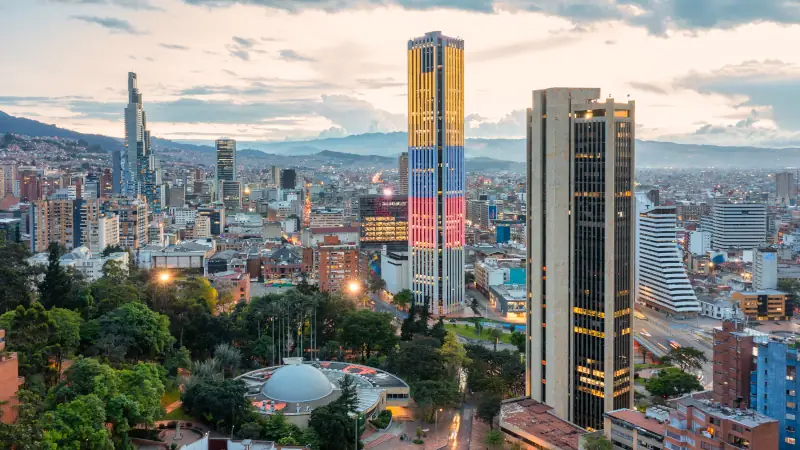
Bogotá, Colombia’s capital city, has managed to stay under the radar as an amazing place for expats seeking a cosmopolitan lifestyle without the big city prices. Some streets are gritty with vibrant graffiti while others are tree-lined and polished. Dramatic green mountains line the northern part of the city.
Neighborhoods like Chapinero have a Brooklyn vibe where creativity booms and buildings hide secret hipster cafés, art galleries, and cocktail bars that you wouldn’t know about unless a local filled you in.
While Bogotá is one of the most expensive cities in Colombia, its culture and food scenes can’t be beat. This is a destination for people looking to experience a booming gastronomic scene, live theater, art, fashion, and film festivals. The largest city in Colombia is definitely one of its best-kept secrets.
Bogotá enjoys a mild climate year-round, with temperatures similar to a warm fall day. During the day it’s typically 67°F (19°C), which is perfect for a light jacket or short sleeves if the sun is out (the sun is surprisingly intense).
In the evening, it’s usually 50°F (10°C), so you’ll need a heavier jacket, but it’s still comfortable. The climate is similar to San Francisco’s… No one has heaters or air conditioning, which keeps electricity bills super low.
The expat community in Bogotá is small but growing. You’ll want to have a good grasp of Spanish to really enjoy life here.
Your cost of living in Bogotá mostly depends on your cost of rent, what you do for entertainment, and where you shop. A budget of $2,000 a month would afford a couple a comfortable life here.
Eating out is one of the best values in Bogotá. Many places offer a menu of the day during lunch for less than $10. This typically includes a soup, main plate, drink, and sometimes a dessert.
Where you shop for groceries can also affect your cost of living. One of the most expensive grocery stores is Carulla, which looks like any North American supermarket. As a new expat, this is probably the first place you’ll shop.
There are several other options for grocery shopping that are much cheaper than Carulla. D1 (De Uno) is a local chain that is famous for having just one brand of everything you could need with affordable prices.
When it comes to entertainment options you’ll be spoiled for choice in this city full of festivals, weekly events, new restaurant openings, and more.
Besides special events happening in the city, there are plenty of things you can do in Bogotá any time of the year. Here are some of the activities that you can’t miss…
Every Sunday, several of Bogotá’s main avenues are shut down for locals to enjoy the calles car-free. It takes place from 7 a.m. to 2 p.m., and thousands of people head out to bike and walk on the normally congested streets.
Parque El Virrey is a gorgeous park located in an upscale area of the city that’s perfect for picnics. The best part is that one of the restaurants surrounding the park can prepare a picnic basket for you.
La Candelaria is Bogotá’s historic district and home to charming cobblestone streets, street art, museums, breweries, and cute cafés. Spending a day here is a must do.
Head to the top of Monserrate for a breathtaking view of the city. Once at the base of the mountain, there is a ticket booth where you can take a cable car to the top for a less than $10 round-trip. You can also walk up the mountain for free between 5 a.m. and 1 p.m., except on Tuesdays.
Bogotá also stands out as a dog-friendly city. Most cafés have outdoor seating where you can bring your dog… A few places don’t mind if you bring them inside. Some of the shopping malls like Hacienda Santa Barbara and Atlantis Plaza even allow you to bring your dog shopping. You’re also allowed to bring your dog on public transportation.
Colombia has 23 of the top 58 best hospitals in Latin America, with 8 of those hospitals in Bogotá. One of the most modern hospitals is Clínica Los Nogales, located in the upscale Chicó Norte neighborhood of Bogotá.
It offers medical services in areas like oncology, orthopedics, general surgery, plastic surgery, reconstructive surgery, hand surgery, urology, intensive care, dermatology, transplants, and so on. It caters to people with private health insurance as well as patients from abroad.
Most expats and retirees want somewhere hot, tropical, and relaxing to call home—Bogotá is the opposite of that.
This is a place for people who want the hustle and bustle of a major city with amazing dining options, culture, and something always going on. You can enjoy the comfortable climate of San Francisco combined with the city lifestyle of New York, but at a fraction of the cost. It’s also for people that want to avoid living in a city full of expats and tourists.
While Bogotá is not the cheapest option in Colombia, it makes sense for the expat that wants to live in a vibrant city with a comfortable climate and low cost of living compared to major U.S. cities.
Why Live Or Retire Here:
- Big City Conveniences At A Fraction Of The Cost Back Home.
- Immerse Yourself In Local Life.
- Rich Cultural And Entertainment Options.
FAQs About Living In Colombia
Our number one choice is Medellín with its growing expat community, welcoming locals, low costs, excellent transport, and spring-like weather year-round… but it will depend on your personal preferences. If you like the beach, look to Santa Marta. If you want to city conveniences and to really immerse yourself in local life, then Bogotá could be your perfect fit.
Colombia has a reputation for crime, and violent and petty crime are still risks here. This might take the form of fairly innocuous scamming (such as not getting the correct change in the grocery store—always count it) to more serious offenses, like a purse-snatching or mugging.
You’ll need to be mindful of safety on a day-to-day basis living here. That said, the longer you live here, the more awareness you’ll develop about how to stay safe.
Yes, in all our preferred spots in Colombia a budget of $2,000 a month will cover your costs.
With easy residency options, excellent health care, solid infrastructure, welcoming communities, a variety of entertainment and cultural offerings, and a great climate, Colombia can be an ideal haven for retirees.







